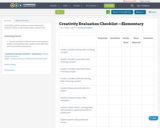
A checklist used by teachers to assess elementary students’ ability to self-evaluate their creative work.
- Subject:
- English Language Arts
- History
- Social Science
- Material Type:
- Assessment
- Date Added:
- 07/03/2017

A checklist used by teachers to assess elementary students’ ability to self-evaluate their creative work.
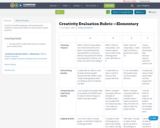
A rubric in student language used by elementary students to assess their ability to evaluate their creative products.
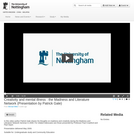
In this video author Patrick Gale shares his thoughts on madness and creativity during the Madness and Literature Network Seminar in 2009. For related videocasts see those presented by Professor Paul Crawford and Paul Sayer.
Presentation delivered May 2009.
Suitable for: Undergraduate study and Community Education
Patrick Gale, Author.
Patrick Gale was born on the Isle of Wight in 1962, where his father was prison governor at Camp Hill prison. Later the family moved to London. He boarded at The Pilgrim's School, where he was a chorister, then went to Winchester College before reading English at Oxford University. He did a series of odd jobs to support his writing before becoming a full-time novelist, moving to Cornwall in 1987. He is the author of several novels, and also writes short stories and novellas. He has written one book of non-fiction, on the American novelist Armistead Maupin, and also writes book reviews for The Daily Telegraph.
His first two novels, Ease and The Aerodynamics of Pork, were published on the same day in 1986. The Facts of Life (1995) tells the story of Edward Pepper, an exile saved from Nazi Germany in the Kindertransport, and Tree Surgery for Beginners (1998) is about Laurence Frost, an inarticulate tree surgeon. A Sweet Obscurity (2003) is told from the alternating viewpoints of four separate characters. Friendly Fire (2003) draws on the author's own experience of a late 1970s adolescence, and Notes from an Exhibition (2007) is set in Cornwall, exploring the effects of mental illness on artist Rachel Kelly and her family.
Important Copyright Information:
You are free to copy, distribute and transmit this video as long as you credit the original author. The video is also available on YouTube

In this video author Paul Sayer shares his thoughts on madness and creativity during the Madness and Literature Network Seminar in 2009. For related videocasts see those presented by Professor Paul Crawford and Patrick Gale.
Presentation delivered May 2009.
Suitable for: Undergraduate study and Community Education
Paul Sayer, Author.
Paul Sayer is a former psychiatric nurse whose first novel The Comforts of Madness (1988) won the Constable Trophy, the Whitbread First Novel prize, and the Whitbread Book of the Year award. His five subsequent books include The Absolution Game (1992), Booker Prize 'long-listed', and Men in Rage (1999) published by Bloomsbury. His work has been translated into ten languages, and he has been the recipient of a number of scholarships, including a Society of Authors travel award and, for 2007/8, a Wingate Scholarship to support the writing of a new novel.
Paul has tutored for Arvon, and has numerous credits for reviews and features in: the Sunday Times, Times, Independent, Literary Review, Time Out, Nursing Standard, Nursing Times, and many more. Psychiatry and psychological sciences remain an interest.
'The Comforts of Madness is surely sad, but enthralling in its excellence. Sayer's style is understated and surehanded.'- New York Newsday
Important Copyright Information:
You are free to copy, distribute and transmit this video as long as you credit the original author. The video is also available on YouTube

Overview: In this lesson, students closely examine Crevecoeur’s third letter in order to understand historically early American literature and the culture. Students critically read the letter and answer critical content questions to increase their knowledge. Students will take a quiz demonstrating their understanding of some of the literature of this period. Finally, in the spirit of early America, students will write their own letters defining what an American is, why immigrants should come, and what the American Dream is or if it is still alive. Students will exchange their letters with a partner for feedback and then turn them in for completion points.
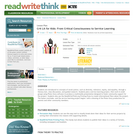
Students take their ideas from the classroom page to the community pavement when they participate in a service-learning project based on their multimedia presentations.
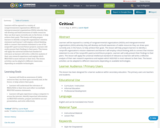
Learners will be exposed to a variety of nongovernmental organizations (NGOs) and intergovernmental organizations (IGOs) whereby they will develop and build awareness of viable resources they can draw upon currently and, in the future, to help achieve their goals. This lesson will help prepare learners to identify a nonprofit organization’s mission statement and learner’s will employ critical thinking skills to connect that mission statement to one of the nonprofit’s past/current/future projects. Learners will orally present their findings to their peers. This lesson will apply the universal intellectual standard of relevance as learners will write a reflective analysis of their own research experience and explain which NGO/IGO is most relevant to their lives. The lesson activities can be adapted to different classrooms depending on available technologies.
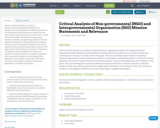
Learners will be exposed to a variety of nongovernmental organizations (NGOs) and intergovernmental organizations (IGOs) whereby they will develop and build awareness of viable resources they can draw upon currently and, in the future, to help achieve their goals. This lesson will help prepare learners to identify a nonprofit organization’s mission statement and learner’s will employ critical thinking skills to connect that mission statement to one of the nonprofit’s past/current/future projects. Learners will orally present their findings to their peers. This lesson will apply the universal intellectual standard of relevance as learners will write a reflective analysis of their own research experience and explain which NGO/IGO is most relevant to their lives. The lesson activities can be adapted to different classrooms depending on available technologies.
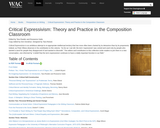
Critical Expressivism is an ambitious attempt to re-appropriate intellectual territory that has more often been charted by its detractors than by its proponents. Indeed, as Peter Elbow observes in his contribution to this volume, "As far as I can tell, the term 'expressivist' was coined and used only by people who wanted a word for people they disapproved of and wanted to discredit." The editors and contributors to this collection invite readers to join them in a new conversation, one informed by "a belief that the term expressivism continues to have a vitally important function in our field."
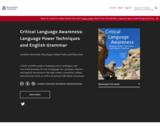
Short Description:
a freely available guide to language power techniques and associated grammar for use in language arts, grammar, rhetoric, and English instruction at the high school, community college, and university levels, as well as by private individuals and groups
Long Description:
This guide to language power techniques (metaphor, doublespeak, pronoun choice, & name-calling) and associated grammar (sentences, nouns, pronouns, & adjectives) includes readings, videos, interactive activities, and discussion and reflection questions. It is an open educational resource for use in language arts, grammar, rhetoric, and English instruction at the high school, community college, and university levels, as well as by private individuals and groups.
Word Count: 54330
(Note: This resource's metadata has been created automatically by reformatting and/or combining the information that the author initially provided as part of a bulk import process.)
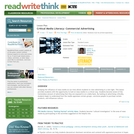
By looking at advertising and mass media critically, students begin to understand how the media oppresses certain groups, convinces people to purchase certain products, and influences culture.
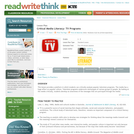
By critically analyzing popular television programs, students develop an awareness of the messages that are portrayed through the media.
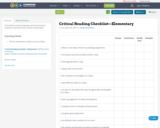
A checklist in student language used by elementary students to self-assess their critical reading skills.
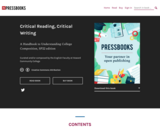
A Handbook to Understanding College Composition, SP22 edition. Curated and/or composed by the English Faculty at Howard Community College.
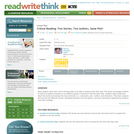
Students make predictions about the stories and analyze story elements, compare and contrast the different stories, distinguish between fact and opinion, and draw conclusions supported by evidence from their readings.

Critical Thinking, Reading, and Writing ultimately help to structure your thinking. This means, you know how to read for different purposes, and articulate and defend your views using support or evidence. These skills will enable you to join the wider academic community of knowledge-building, expansion, and credibility.
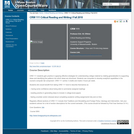
CRW 111 students gain practice in applying effective strategies for understanding college material by relating generalization to supporting ideas and identifying the patterns into which ideas are structured. Students use computers to develop analytical capabilities in the course's computer lab component. CRW 111 carries 3 credits and meets 3 hours per week.
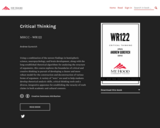
MHCC - WR122
Short Description:
Using a combination of the newest findings in hemispheric science, neuropsychology, and brain development, along with the long-established rhetorical algorithms for analyzing the structure of arguments, this course explores the boundaries of critical and creative thinking in pursuit of developing a clearer and more robust model for the construction and deconstruction of various forms of argument. A variety of "texts" are used to help students develop rhetorical analysis skills, critical thinking tools and a diverse, integrative apparatus for establishing the veracity of truth claims in both academic and cultural contexts.
Long Description:
This project was funded by the MHCC Foundation OER Grant Program and published by MHCC Library Press. MARC record available at the end of the book.
Word Count: 10313
(Note: This resource's metadata has been created automatically as part of a bulk import process by reformatting and/or combining the information that the author initially provided. As a result, there may be errors in formatting.)
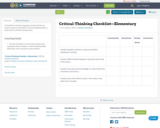
A checklist in teacher language used by teachers to observe and record students’ critical-thinking skills as they work on activities and projects.
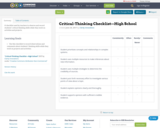
A checklist used by teachers to observe and record students’ critical-thinking skills while they work on activities and projects.